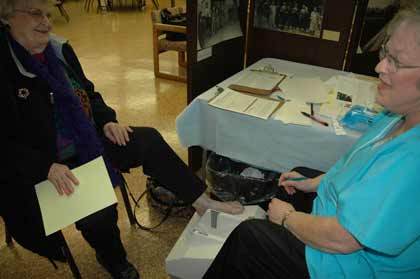Frances Noggle is doing everything right.
The 83-year-old Buckley woman is taking calcium and vitamin D and eats calcium-rich foods. She walks regularly. She doesn’t smoke. She rarely drinks coffee. And, Thursday, she was at the Enumclaw Senior Activity Center getting an osteoporosis screening.
Osteoporosis is a disease where bones become weaker and are more likely to break. Bones are living tissue that constantly renew themselves. When the cells that take bone away work faster than the cells that build bone, it can cause bone loss. Brittle bones can easily break in a minor fall or if the bones are weak enough from the force of a sneeze.
And it happens without anyone realizing it. People don’t feel or see their bones getting weak.
The simple, free test is especially important for women older than 50, but is equally recommended for aging men.
According to the National Osteoporosis Foundation, about 85 to 90 percent of adult bone mass is acquired by age 18 in girls and age 20 in boys. Building strong bones during childhood and adolescence can help to prevent osteoporosis later in life.
Women reach their peak bone mass at 30 years old.
“They can build bone until the’re 30 and then they start to lose it,” said Rachel Hoornstra, the technician from California-based Onsite Wellness, who was performing Thursday’s screenings.
“It’s an indicator,” Hoornstra said. “It’s a screening. If you have a high rating here than you should see your doctor.”
The screening measures bone density in the heel of the foot, which is close to the density of the hip, and that’s important.
According to the NOF, a woman’s risk of hip fracture is equal to her combined risk of breast, uterine and ovarian cancer.
The number of fractures due to osteoporosis is expected to rise to more than 3 million by 2025, notes the NOF. In 2005, about 293,000 Americans age 45 and older were admitted to hospitals with a fracture of the femoral neck, a common type of hip fracture. Osteoporosis was the underlying cause of most of these injuries.
Breaking a hip can nix retirement plans or an active lifestyle.
The rate of hip fractures is two to three times higher in women than men, according to the NOF, however, the one-year mortality following a hip fracture is nearly twice as high for men as for women.
“Sometimes men don’t believe they need this,” Hoornstra said. “but they get hip fractures too, just like women.” She said men are more likely to start dropping bone density in their 40s and 50s.
The National Osteoporosis Foundation points out an average of 24 percent of hip fracture patients aged 50 and older die in the year following their fracture and one in five of those who were ambulatory before their hip fracture requires long-term care afterward.
The statistics can be scary, that’s why the National Osteoporosis Foundation and other organizations recommend a bone density scan, especially for woman 65 years old or older. For those who have additional risk factors which can include a family history of osteoporosis; Caucasian or Asian ethnicity; drink alcohol or smoke often; or have been on bone-thinning medications like steroids.
There are things to do to help slow bone’s from thinning.
Taking vitamin D and calcium are one of the recommendations. The two go hand-in-hand with vitamin D helping the body absorb calcium. Those who live in areas like California get vitamin D naturally from the sun, here in the cloudy Northwest, taking a supplement can help.
Sources recommend women more than 50 years old get 1,200 milligrams of calcium a day. Adults under 50 should get between 400 and 800 International Units (IU) of vitamin D daily and those 50 and older should aim for between 800 and 1,000 IUs.
Many people can forego the supplement by eating calcium-rich foods in their natural diet. Cheddar cheese, yogurt, milk, almonds, white beans, spinach, salmon, sardines, broccoli, leafy greens and ice cream are a few. For example, a 1.75 ounce of cheddar cheese contains 363 mg of calcium. A half-cup of almonds contains 206 mg.
Weight-bearing exercises like walking, stair climbing, hiking, tennis and dancing can also help maintain bone density.



